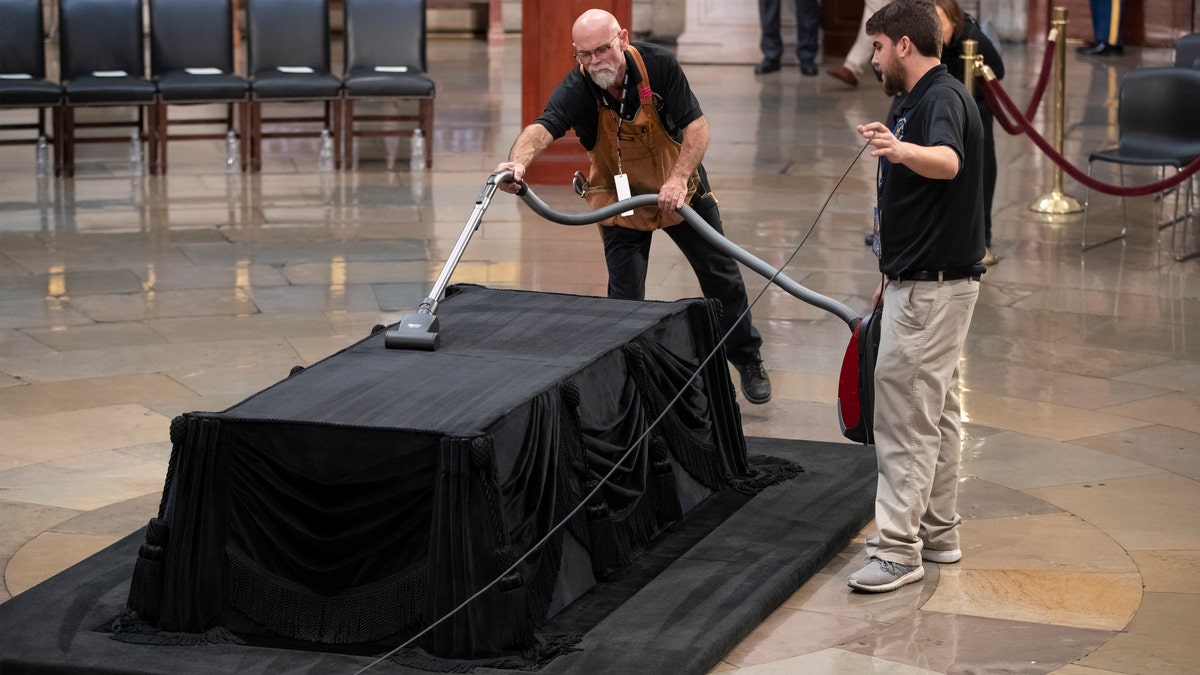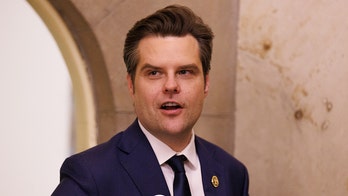'Special Air Mission 41' to fly Bush casket to DC
Former President George H.W. Bush to lie in state in the U.S. Capitol rotunda; Casey Stegall reports from the funeral home in Houston.
When George H.W. Bush lies in state this week, he will be the 12th president to do so.
The 41st president died on Nov. 30 at his home in Houston at the age of 94. His body will arrive Monday in Washington, D.C., where he will lie in the Capitol rotunda for three days, giving the public a chance to mourn. Bush will then be transported back to Texas for another service and his burial.
Presidential funerals are planned far in advance, and the family receives help from the military to coordinate the events.
Read on for a look at some of the traditions created from past presidential funerals and how they’ve been handled over the years.
One president in recent history didn’t have a state funeral

The official portrait of former President George H.W. Bush is draped in black cloth at the National Portrait Gallery before he will lie in state at the Capitol building this week. (AP Photo/Andrew Harnik)
Out of the five presidents who have died in the past 30 years – including Bush – only one did not have a state funeral.
President Richard Nixon was remembered at a service at his library in California before he was buried next to his wife, according to the White House Historical Association. His family thought visitors to the Capitol might not be respectful toward Nixon, who resigned from the office.
GEORGE H.W. BUSH'S FUNERAL, MEMORIAL SERVICES: EVERYTHING YOU NEED TO KNOW
However, former Presidents Gerald Ford, Ronald Reagan and Lyndon B. Johnson did have state funerals, as will Bush.
Bush will be the 12th president to lie in state. State funerals typically last about five days.
The planning begins immediately
Presidents must begin planning their funeral “early in each presidential term,” according to the White House Historical Association.
“It is a cold realization that greets a new president at the White House door,” the association said.
“In many ways, funeral services are [a] final conversation with the nation, and illustrate something about the man and the way in which he wishes to be remembered,” the association also said, noting Ford needed to be persuaded to include certain elements in his funeral.
A military task force assists with state funerals

Members of the U.S. Secret Service carry the casket with former President George H. W. Bush to a hearse after a family service. (AP Photo/Kiichiro Sato)
The Joint Task Force-National Capital Region (JTF-NCR) assists with carrying out the funerals.
When a former president dies, the current president issues a “proclamation” which allows the Department of Defense “to conduct a state funeral on behalf of the nation,” according to the JTF-NCR. The JTF-NCR commander will be in charge of coordinating the ceremonies.
The president’s family could also choose to incorporate certain military honors during the funeral services, such as a flag-draped casket, military flyover, 21-gun salute or a guard of honor.
Washington was mourned for 69 days
After the death of America’s first president, George Washington, the nation had 69 days of public mourning, according to the National Library for the Study of George Washington at Mount Vernon.
For Bush, President Trump declared Dec. 5 to be a day of public mourning.
Harrison set the tone for state funerals
William H. Harrison was the first president to die in office and the first to have a state funeral.
Planned by merchants Alexander Hunter and Darius Clagett in 1841, mirrors and chandeliers in the White House were covered with black drapes after Harrison's death, according to the White House Historical Association. His casket was carried in a car driven by horses also draped in black.
GEORGE HW BUSH TO BE LAID TO REST IN SOCKS PAYING TRIBUTE TO MILITARY SERVICE
He was temporarily buried in the Congressional Cemetery until the ice melted, and he was then taken to Ohio.
The 30-day ordeal drew inspiration from royal funeral ceremonies, according to the association.
Lincoln’s mark

Mike Dean, lead upholsterer for the House of Representatives, and John Brady Jr., an apprentice, prepare the Lincoln catafalque for the casket of former President George H.W. Bush. (AP Photo/J. Scott Applewhite)
When someone lies in state – even those who were not presidents – the casket is placed on the catafalque, a wooden platform used for President Abraham Lincoln’s funeral in 1865.
The black cloth that covers the catafalque has been replaced throughout the years, and its base and platform have been altered to accommodate larger coffins, but it has otherwise remained much the same, according to the Architect of the Capitol.
Fox News' Chad Pergram and The Associated Press contributed to this report.





